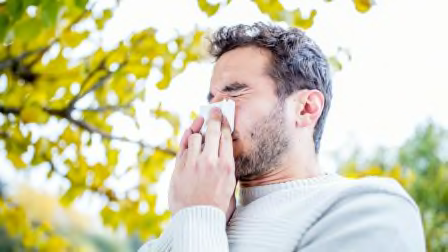Your Questions About RSV, Answered
The respiratory illness can be dangerous for young children and older adults. But new immunizations are available for the first time this fall.

Fall isn’t just the start of school and football season—it’s the kickoff of respiratory virus season, too.
Along with the flu, colds, and now COVID-19, one of the typical bugs that marks the season is respiratory syncytial virus (RSV), which causes colds in older children, but can be quite severe for babies as well as older adults.
Every year, RSV has a significant impact, says Elizabeth Murray, DO, a pediatrician specializing in emergency medicine at the University of Rochester Medical Center in New York. It’s the leading cause of hospitalizations for infants in the U.S.—between 50,000 and 80,000 kids under 5 are hospitalized with the illness each year.
The 2022 RSV season was particularly bad, with the virus arriving earlier than usual. And some data suggests that even without a similar early arrival, there could be even more RSV cases this year than in the prior season. But there are also two new tools arriving that could help lessen the impact of RSV and help prevent some of the most severe cases and deaths.
This summer, the Food and Drug Administration approved a preventative antibody treatment that can be given to infants and some high-risk young children during RSV season, and it’s recommended by the Centers for Disease Control and Prevention.
In This Article
• Why Was RSV Season So Bad Last Year?
• What Will RSV Season Be Like This Year?
• What Are the Symptoms of RSV?
• Why Is RSV Sometimes Severe for Young Kids?
• What Is the Antibody for Kids? Is It a Vaccine?
• Does the Antibody Cause Side Effects?
• How Effective Is Nirsevimab, the New Antibody for Babies?
• Who Can Get Nirsevimab?
• How Much Will Nirsevimab Cost?
• Is Nirsevimab Available Now?
• What About the RSV Vaccine for Older Adults?
• Can Pregnant People Get an RSV Vaccine?
• What Else to Know About Respiratory Viruses This Season
Why Was RSV Season So Bad Last Year?
Typically, RSV starts to spread in the continental U.S. around the start of October—usually before the flu. But in 2022, RSV (as well as the flu) surged early, starting in the summer. “It took everybody off guard and completely overwhelmed hospital systems, especially pediatric hospital systems,” says Tina Tan, MD, a pediatric infectious disease specialist and professor of pediatrics at Northwestern University in Chicago.
The general consensus is that because of COVID-related precautions, the number of children who had never been exposed to RSV before was unusually high, says William Schaffner, MD, a professor of infectious diseases at Vanderbilt University Medical Center in Nashville, Tenn.
Typically, kids first catch the virus during their first year of life. But when kids started to return to school and normal activities, it was not just infants experiencing their first exposure to RSV—it was also older kids. That provided an opportunity for the virus to spread “early and vigorously,” Schaffner says.
Still, RSV is bad pretty much every year, Tan says. Last year, however, was especially bad, given all the kids encountering it for the first time at the same time that COVID-19 and the flu were circulating.
What Will RSV Season Be Like This Year?
This year, we haven’t seen the same early surge of RSV. Because of that, researchers anticipate that the start of RSV season is likely to be at the more typical time, Schaffner says—generally early October.
Yet even on a normal time frame, the season could still be bad: Experts often see respiratory virus season in the Southern Hemisphere as a sort of preview of the respiratory virus season in the U.S. and Europe. And during their respiratory virus season this year, some parts of Australia saw 10 times as many RSV cases as they saw the previous year, Tan says.
What Are the Symptoms of RSV?
In older kids and adults, RSV—like many other respiratory viruses—causes coldlike symptoms, including runny nose, coughing, decreased appetite, fever, sneezing, and wheezing. Unlike with the flu, where symptoms often appear all at once, the symptoms of RSV tend to appear in stages about four to six days after infection.
It’s difficult for parents to tell the difference among various respiratory viruses, but pediatricians can often quickly identify an RSV cough. Providers can also diagnose the virus with a test if needed, though there is no specific treatment for RSV—in most cases, kids just need rest, hydration, and sometimes ibuprofen or acetaminophen. (For more on staying healthy and taking care of sick kids, see our respiratory season survival guide for parents.)
Most RSV infections go away within a week or two.
Why Is RSV Sometimes Severe for Young Kids?
RSV can cause inflammation of the small airways in the lung, known as bronchiolitis, and pneumonia, a lung infection. These can cause difficulty breathing, especially in young children, who have particularly small airways. People who are struggling to breathe often require hospitalization, where babies or young kids with RSV may receive oxygen, IV fluids, or—in the most serious cases—mechanical ventilation. Most hospitalizations for RSV last only a few days, according to the CDC.
Signs of breathing trouble in a young child include breathing much faster than normal or using the abdominal muscles to breathe, or if it appears that a child’s chest is sinking under the collarbone or ribs as they breathe. Grunting, nose flaring, and blueish color around the fingernails or mouth are other emergency signs. Older kids may appear unable to catch their breath enough to talk. These are all urgent signs that you should go to the emergency department.
What Is the Antibody for Kids? Is It a Vaccine?
In July, the FDA approved nirsevimab, a type of treatment known as a monoclonal antibody, to help prevent RSV in infants and younger children at higher risk for severe cases of RSV.
This product is not a traditional vaccine but it is intended to provide protection against infection that should last for at least five months.
Vaccines provide active immunization, Schaffner says—they teach your body to recognize an infection with a specific pathogen and then to respond by creating antibodies that fight the infection. This shot just puts the antibodies directly into a child, in a process known as passive immunization. “A traditional vaccine is like a cookbook, it teaches the body [to make antibodies],” Murray says. “This is like ordering takeout.”
Does the Antibody Cause Side Effects?
When your body responds to an infection or to vaccination, the immune system’s response can cause side effects of varying severity, something that’s known as reactogenicity—that’s why your arm sometimes feels sore after a flu shot.
But since this direct antibody injection skips the need for your body to react and create antibodies, this injection doesn’t appear to cause many side effects at all, Murray says. In clinical trials, the most commonly reported adverse side effect was a mild to moderate rash at the injection site—though even that was pretty uncommon.
There doesn’t appear to be any concern that the injection could cause a fever, which is what makes it safe to give to very young infants, Murray says. (Fevers in newborns and infants under two months are considered a medical emergency. That’s 100.4° F or more rectally.)
How Effective Is Nirsevimab, the New Antibody for Babies?
According to clinical trial data from AstraZeneca and Sanofi, makers of Beyfortus (the brand name for nirsevimab), the injection is about 77 percent effective against hospitalization for RSV-associated lower respiratory tract infection, and about 76 percent effective against RSV infections requiring medical care.
“There is so much enthusiasm about this in the community of providers who care for babies and young children,” Schaffner says.
Who Can Get Nirsevimab?
According to recommendations from the CDC’s Advisory Committee on Immunization Practices, healthy infants who are under 8 months of age going into or during their first RSV season can get one dose of nirsevimab. Once a child reaches 8 months of age, they are no longer eligible, according to the American Academy of Pediatrics. Kids born during RSV season (Oct. 1 through March 31 in the continental U.S.) will ideally receive a dose during their first week of life, often at the hospital soon after they are born, according to the AAP.
Some kids ages 8 months to 19 months who are at a higher risk for severe RSV are also eligible for a dose of nirsevimab during or shortly before the season. These include children with chronic lung disease or prematurity, severely immunocompromised children, children with cystic fibrosis with manifestations of severe lung disease, and American Indian or Alaska Native children, according to the AAP and CDC.
If nirsevimab isn’t available for kids at higher risk for severe RSV, there is another already available preventative antibody treatment, palivizumab, available for infants who were born prematurely and certain other higher-risk groups. But palivizumab provides protection for only about a month. To protect kids through the peak of the season, doctors typically recommend a five-dose course, with doses spaced about a month apart.
How Much Will Nirsevimab Cost?
According to the AAP, nirsevimab will be covered by insurance and by the Vaccines for Children program, a federal program designed to ensure that vaccines are available to kids who otherwise would not be able to afford them. Some pediatric providers say they are still waiting for confirmation from commercial insurers that nirsevimab will be covered before they can say whether or not there will be an out-of-pocket cost.
Is Nirsevimab Available Now?
Not quite yet. Final details of the rollout are still being worked out, according to Murray, but it should be available soon—and parents of eligible children should talk to their pediatricians about it as soon as they hear it’s available, she says. Administration of nirsevimab should begin in early October, according to AAP.
What About the RSV Vaccine for Older Adults?
RSV can cause serious complications for older adults, just like in young children. According to the CDC, between 60,000 and 160,000 older adults are hospitalized for RSV each year, with between 6,000 and 10,000 deaths. The highest-risk older adults include those with weakened immune systems, those with chronic heart or lung disease, and those living in nursing homes or other long-term-care facilities.
In May, the FDA approved Arexvy, a vaccine against RSV created by GlaxoSmithKline, for adults 60 and older, based on data showing it reduced the risk of developing lower respiratory tract disease by 83 percent. Commonly reported side effects include injection site pain, fatigue, muscle pain, headache, and joint stiffness.
That same month, the FDA also approved another similar vaccine called Abrysvo made by Pfizer, based on data showing it reduced the risk of lower respiratory tract disease by 89 percent. The most commonly reported side effects included fatigue, headache, pain at the injection site, and muscle pain.
There were also some rare events in the studies of both vaccines.
During clinical trials of Arexvy, three of the 17,922 participants experienced inflammatory neurological events within 42 days of vaccination. One participant developed Guillain-Barré syndrome (GBS). Two participants from another study of people who got both Arexvy and a flu vaccine at the same time developed a rare type of brain and spinal cord inflammation; one of them died. There were also several more cases of irregular heart rhythm, known as atrial fibrillation, in study participants who received the vaccine than there were in the placebo group.
During clinical trials of Abrysvo, three of 20,255 participants experienced inflammatory neurological events within 42 days of vaccination, including a case of GBS and a GBS variant, and another neurological event that involved a worsening of preexisting symptoms. There were also several more cases of atrial fibrillation in vaccine recipients than in placebo recipients.
Researchers and manufacturers will continue to monitor and investigate the potential risks of both vaccines.
Arexvy and Abrysvo are available for adults 60 and older at pharmacies and healthcare providers. They should provide at least some protection for two seasons, according to the CDC, and can be administered alongside other vaccines like the flu shot.
Can Pregnant People Get an RSV Vaccine?
In August, the FDA approved Pfizer’s Abrysvo RSV vaccine for pregnant people between the 32nd and 36th weeks of their pregnancy, and on September 22, the CDC recommended the vaccine for these individuals.
Clinical trial data indicates that among 3,500 individuals who received Abrysvo during pregnancy, the vaccine reduced the risk of severe lower respiratory tract disease in their babies by 82 percent in the first three months of life and 69 percent within the first six months of life.
In the trial, there were more preterm births in Abrysvo recipients than in placebo recipients (5.7 percent compared with 4.7 percent, with insufficient data to say whether or not Abrysvo increases risk of preterm birth). Both to avoid an increased risk for preterm birth and to maximize protection immediately after birth, the vaccine is not recommended before 32 weeks.
This vaccine is already available at some locations, and availability is expected to increase in the coming weeks, according to the CDC.
What Else to Know About Respiratory Viruses This Season
It’s not just RSV but also other colds, the flu, and COVID-19 that we need to prepare for right now, Tan says. If there’s a vaccine for any of these illnesses you qualify for, you should get it, she says. “The best way to protect yourself from complications and dying is to get vaccinated. That is our best tool for protection.”
Pediatricians tell people to try to get their flu shot before Halloween—“flu before boo,”—Murray says. New COVID-19 vaccines targeting currently circulating strains of COVID-19 are also now available, and recommended for anyone 6 months and older. Aside from that, typical precautions remain the best advice we have. Wash your hands regularly, try to stay home when sick, consider wearing a mask in crowded places, and don’t send sick kids to school.




















